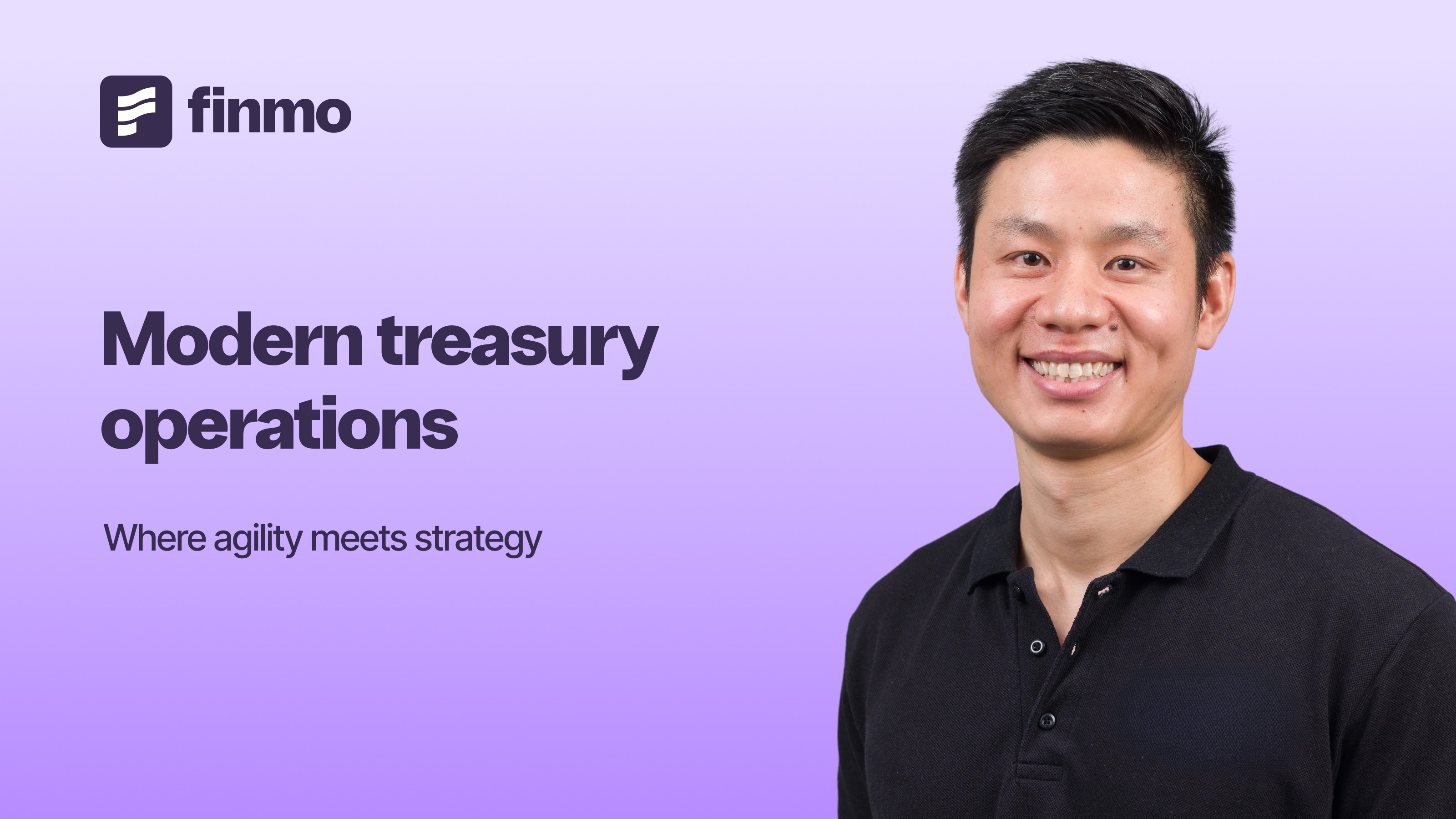Back to blogs
Author
Jonathan Lew
CFO & COO, Finmo
The role of the modern CFO has grown significantly. No longer simply a ‘guardian of ledgers’, CFOs are now expected to be a strategist, tech-savvy risk navigator, and orchestrator of capital in an era of uncertainty. They must guide the company through supply chain disruptions, interest rate volatility, foreign exchange (FX) fluctuations, and rising regulatory complexity.
“The expectations of today’s CFO go far beyond financial stewardship,” says Jonathan Lew, Chief Financial Officer at Finmo. “We’re asked to steer through uncertainty, guide digital adoption, and partner with the CEO on growth strategy. But you can’t do that if you’re flying blind on cash, liquidity, and risk. In 2025, treasury is no longer a back-office concern—it is the cockpit of strategy. CFOs who lack real-time control of cash, risk, and liquidity aren’t just behind on efficiency; they are compromising growth and resilience.”
Despite these high expectations, the most vital strategic element, treasury operations, is often overlooked. Many mid-market CFOs only engage with treasury operations during a crisis, whether it's a liquidity squeeze, FX revaluation, or challenges arising from global expansion. As Jonathan puts it: “Too often, treasury only comes to the surface when there’s a problem. That reactive posture means we miss the chance to use treasury as a proactive driver of value.”
Without real-time systems to oversee cash, liquidity, and risk, CFOs are forced to make strategic decisions based on outdated reports rather than current insights.
Traditional Treasury Infrastructure Creates Blind Spots
In many organisations, treasury infrastructure remains fragmented. Liquidity is spread across multiple bank accounts, currencies, and jurisdictions. Forecasting is static, based on outdated data. Payments, reconciliations, and FX risk assessment occur in disconnected, heavily manual workflows.
A striking 43% of finance teams report lacking the information needed to make informed decisions, according to industry reports. By the end of the month, time many assumptions may already be outdated, affecting decision-making.
Meanwhile, the 2025 EACT Treasury Survey highlights cash flow forecasting overtaking long-term funding as the top priority, with increasing demand for improved visibility on inflows and outflows. However, many treasuries still depend on batch reporting and offline spreadsheets, missing the chance to act with greater agility.
Why 2025 Is the Tipping Point
Treasury operations have always been essential, but their operational reality has lagged behind their strategic importance. A decade ago, treasury operations were still a monthly or quarterly process. Data flowed in batches, often days or weeks after events. Forecasts were created in spreadsheets, reconciliations were manual, and execution was handled in separate systems from reporting.
In the last five years, APIs started to link banks with ERPs, instant payment schemes appeared, and early AI tools hinted at predictive capabilities. But adoption remained inconsistent, and many CFOs still viewed treasury infrastructure as an operational afterthought.
The year 2025 marks a pivotal moment. Jonathan notes: “For the first time, the technology is mature, affordable, and accessible. APIs, instant payments, and AI forecasting aren’t future tools - they’re available now. The CFOs who embrace them will redefine how treasury supports strategy.”
Reframing Treasury as the CFO’s Growth Radar
When redefined as a strategic pillar, treasury helps detect risks and spot opportunities. “It tells you where the risks are coming from and where the opportunities lie. With the right infrastructure, you’re no longer reacting to yesterday’s numbers, you’re shaping tomorrow’s decisions,” Jonathan explains.
A strategic treasury operation delivers:
Integrated liquidity management: Centralising visibility of all cash positions across entities and currencies allows CFOs to pool funds, optimise interest income, and reallocate capital in hours rather than days.
Unified FX and risk visibility: Live tracking of currency exposures means finance leaders can lock in favourable rates before market swings erode margins.
Connected cash flow and payments framework: By linking payment execution directly to forecast models, treasury can ensure every outgoing transfer is aligned with projected inflows.
The 2025 PwC survey data shows that CFOs operating with this integrated approach are 1.7 times more likely to participate in C-suite strategic decision-making.
The Competitive Advantage of Modern Treasury Infrastructure
As of 2025, real-time treasury management has shifted from a competitive advantage to an industry standard. Instant payment systems and API-based bank connectivity now enable CFOs and treasury teams to monitor cash flows continuously and make adjustments within the same day.
The real transformation is strategic. CFOs who adopt modern treasury infrastructure can anticipate challenges, respond more quickly than competitors, and build confidence among boards and investors The real transformation is strategic. CFOs who adopt modern treasury infrastructure can anticipate challenges, respond more quickly than competitors, and build confidence among boards and investors.
Investor expectations are shifting too. Boards and shareholders increasingly demand real-time clarity on liquidity and risk exposure, and research shows that companies with integrated treasury reporting are more likely to secure favourable credit terms and inspire investor confidence. Modern treasury isn’t only about internal control, it’s equally about external trust. Boards, investors, and lenders want real-time clarity on liquidity and risk before they extend confidence or capital. By modernising treasury infrastructure, CFOs can anticipate challenges, respond faster than competitors, and influence the company’s future with speed, clarity, and foresight.
How Finmo Transforms Treasury for the Modern CFO
Finmo sits at the crossroads of strategy and execution. Its treasury-first design turns infrastructure into outcomes that matter to finance leaders:
Capital Agility: Move money with speed and precision, ensuring liquidity is never idle. A centralised view of global cash positions enables faster pooling and redeployment of funds where they’re needed most.
Risk Resilience: Mitigate volatility before it hits the bottom line. Real-time reconciliations and embedded scenario modelling keep cash and FX positions accurate, enabling hedges and funding moves based on live data, not stale reports.
Operational Efficiency: Cut friction, errors, and wasted hours. Automation reduces manual effort, streamlines reconciliations, and ensures payment flows align with forecast inflows, freeing teams to focus on higher-value work.
Strategic Clarity: Spend less time firefighting and more time shaping growth. Forward-looking analytics and scenario planning provide the insight to guide CEO and boardroom conversations with confidence.
The system provides not just efficiency, but strategic capacity: CFOs can reallocate capital, respond to FX shifts, and support strategic initiatives—without toggling between systems.
The Future Starts Now
For CFOs, this future is being built today. The infrastructure decisions made now will determine whether their operations are prepared to plug into these innovations or be left behind.
As Jonathan explains: “We are witnessing a pivotal shift. Treasury is moving from a static support function to the CFO’s true operational radar. In real time, strategic treasuries drive capital allocation, risk mitigation, and growth in an unpredictable world. The decisions CFOs make today on treasury infrastructure will define whether they are ready for that future—or left behind by it.”
Finmo’s approach - connected, integrated, and cloud-native is built for scalability. It provides CFOs with connected, future-facing financial intelligence and the flexibility to start small and expand as they grow, all without displacing their core systems.
In 2025, strategy begins with treasury. For the CFO ready to move from payments to ambition, this intelligence is essential. Looking to modernise your treasury operations?








